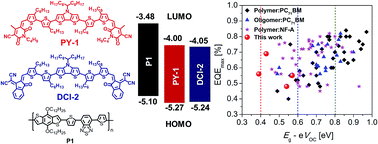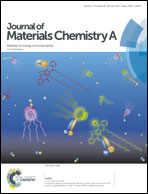Unprecedented low energy losses in organic solar cells with high external quantum efficiencies by employing non-fullerene electron acceptors†
Abstract
In order to realize high photocurrent generation in the low-energy region of the solar spectrum, two conjugated A–D–A oligomers, PY-1 and DCI-2 comprising a central dithieno[3,2-b:2′,3′-d]pyrrole donor (D) unit and end-capping acceptors (A) 1-butyl-4-methyl-2,6-dioxopyridine-3-carbonitrile (PY) or 3-dicyanomethyleneindan-1-one (DCI) have been synthesized and characterized. The oligomers showed strong absorptions in the red and near-IR region in solution and in the solid state. As a consequence of the strong electron-accepting character, the absorption band of DCI-2 in thin films is significantly red-shifted compared to that of PY-1 resulting in a low optical energy gap of 1.23 eV. In optimized solution-processed bulk-heterojunction solar cells using a polymeric donor P1, the new non-fullerene acceptor DCI-2 provides an excellent power conversion efficiency of 6.94% which is noticeably higher than that of PY-1-based devices (PCE = 4.89%). Most importantly, a high open-circuit voltage (VOC) of ∼0.8 V with unprecedented energy losses, between the optical energy gap and the open-circuit voltage, between 0.39 and 0.43 eV concomitant with excellent external quantum efficiencies of 69%@880 nm in the NIR-regime have been achieved for DCI-2-based devices.



 Please wait while we load your content...
Please wait while we load your content...